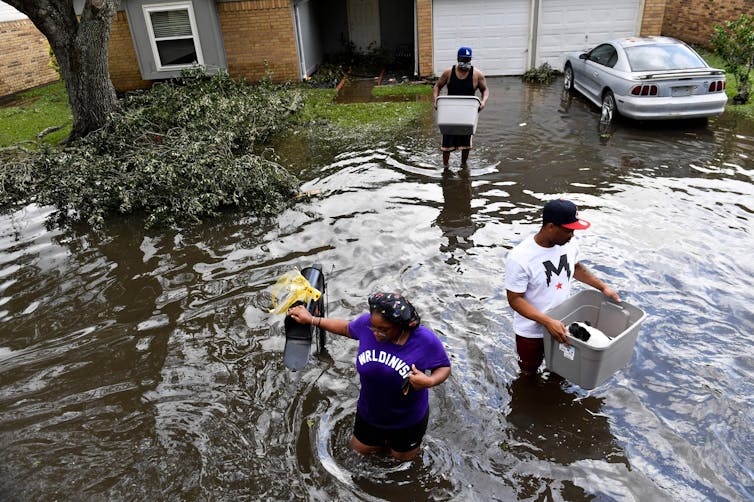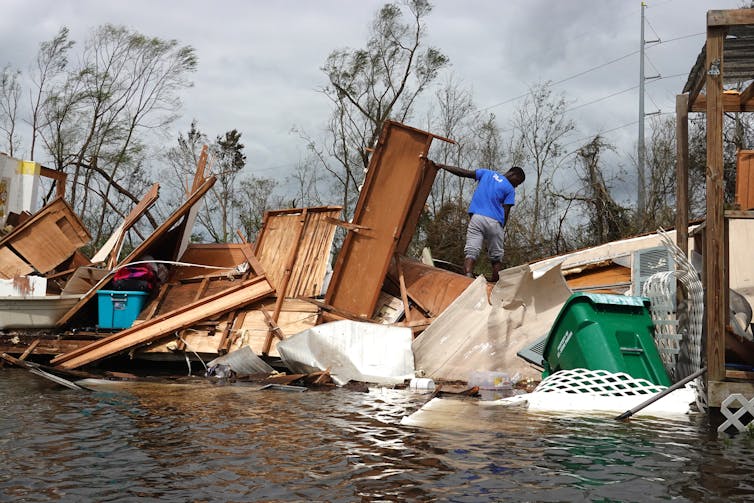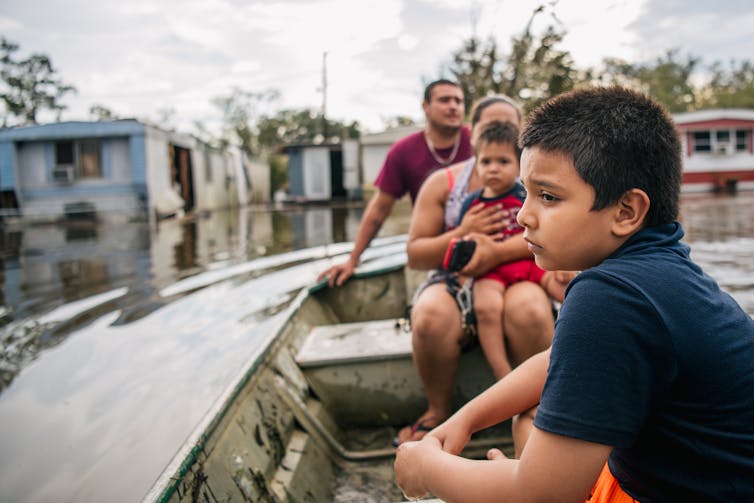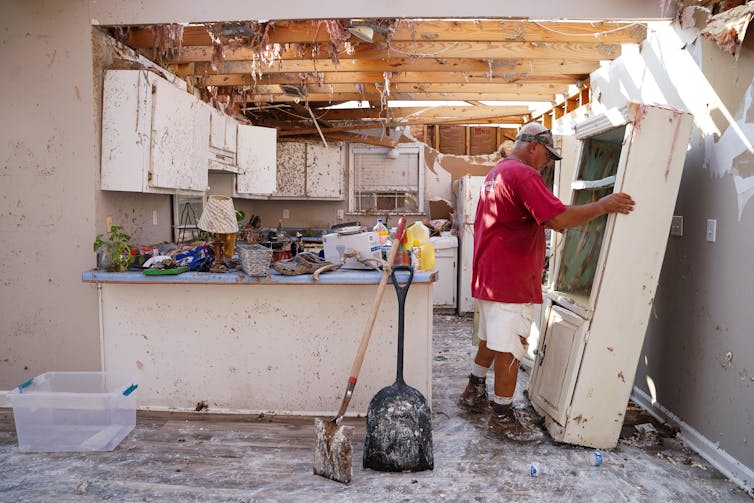Much of the climate-related homelessness and permanent displacement could be prevented if the U.S. government invested in preparedness, say the authors.

People wade through high water to evacuate a flooded home in LaPlace, La., after Hurricane Ida struck. (Patrick T. Fallon/AFP via Getty Images)
The Conversation

 Hurricane Ida hit New Orleans on Aug. 29, 2021, 16 years to the day after Hurricane Katrina flooded the city. This time the levees held. Billions of dollars invested in reinforcing them had paid off – at least for part of the population.
Hurricane Ida hit New Orleans on Aug. 29, 2021, 16 years to the day after Hurricane Katrina flooded the city. This time the levees held. Billions of dollars invested in reinforcing them had paid off – at least for part of the population.
A strong similarity between Ida and Katrina still emerged: Low-income communities and communities of color remain at high risk from hurricanes.
As scholars who study refugees and migration worldwide, we are finding that the communities most at risk are being pushed into permanent displacement and homelessness, or deeper into poverty, with each climate-related disaster. Much of this could be prevented if the U.S. government invested in preparedness and did more to protect vulnerable communities.
‘Hunker Down’
Despite years of preparations, New Orleans Mayor Latoya Cantrell said there was no time to issue a mandatory evacuation order as Ida rapidly intensified into a powerful Category 4 hurricane. She urged city residents to “hunker down.” Mass evacuations require coordination among multiple parishes and states, and there wasn’t enough time. In several surrounding parishes, people were told to evacuate, but in low-lying and flood-prone locations, many residents couldn’t afford to leave.
Hurricane Ida became the most destructive storm of the busy 2021 Atlantic hurricane season that ends Nov. 30. It was one of seven named storms to hit the U.S. as the season exhausted the list of tropical storm names for the second year in a row.
While many New Orleans residents breathed a sigh of relief as Ida’s storm surge subsided, the damage outside the city’s levee system was devastating.
In St. John Parish, about 30 miles northwest of New Orleans, Ida’s storm surge flooded the largest town, LaPlace, whose residents have faced many natural disasters over the years. Most LaPlace residents couldn’t afford to evacuate. When the storm hit, people pleaded for boat rescues. Two months later, residents were still waiting for repairs, and some were contemplating leaving permanently.
Native communities living in the bayous of coastal Louisiana are also facing the risk of permanent displacement. One example is the Houma people, who saw many of their homes damaged or destroyed. The Houma have been recognized by the state as a tribe since 1972 but are not recognized by the federal government and thus are not eligible for federal community assistance. Instead, members apply for assistance as private citizens. Many were left without housing, and their displacement erodes the Houma’s sense of community and connection to their land.

Many residences in LaPlace, La., were unlivable after Hurricane Ida. (Scott Olson/Getty Images)
FEMA Aid Favors Wealthier Homeowners
In many parts of the U.S., the legacy of segregation means that low-income communities are more likely to live in high-risk areas. When Hurricane Harvey flooded Houston in 2017, for example, low-income neighborhoods were most affected. According to the Greater Houston Flood Mitigation Consortium, a quarter of affordable, multifamily housing lies within a currently mapped floodplain and is vulnerable to future flooding.
As disasters become more frequent in a warming climate, low-income people without adequate assistance in flood- and hurricane-prone areas are likely to be permanently displaced, as it will be too costly to try to rebuild.
Agencies like the Federal Emergency Management Agency, the Army Corps of Engineers and the Department of Housing and Urban Development all respond to climate-related emergencies. But the absence of any central coordinating agency means the government’s response tends to be disorganized and can even contribute to deepening inequalities.
FEMA, the main source of post-disaster funding, focuses primarily on recovery and reconstruction of property, which favors homeowners and wealthier individuals. The aid is allocated based on cost-benefit calculations designed to minimize taxpayer risk.
When property values are higher, FEMA’s payments for damages are higher, making it easier for wealthier neighborhoods to rebuild. As a result, the majority of the funds are not given to those who need them most but rather to those whose property is worth more.

Low-income communities along the Louisiana coast were hit hardest by Hurricane Ida. (Brandon Bell/Getty Images)
FEMA’s Individual Assistance Program provides financial assistance to those who are uninsured, but the program cannot pay for all disaster-related losses. Federal assistance comes either as a loan or as a FEMA grant of about US$5,000 per household. But the average flood insurance claim in 2018 exceeded $40,000, according to FEMA.
The National Flood Insurance Program helps those who can afford the insurance. But those who are uninsured aren’t able to recover their losses. Disaster cycles ensue in which those who are most at risk cannot access funding either to prepare for disasters or to recover from them.
For example, in cases of urban flooding, families who own homes can get up to $30,000 in FEMA grants for rebuilding and recovery. If they have higher incomes, they can also benefit from a tax refund. Wealthier individuals are also more likely to apply for Small Business Administration low-interest disaster loans.
In contrast, low-income families who are uninsured or who rent a home often receive smaller grants from FEMA and do not qualify for significant tax refunds or SBA loans due to low credit scores.

Federal disaster aid focuses on rebuilding damaged homes, including in high-risk locations. (Sean Rayford/Getty Images)
This means that those with wealth and high incomes experience a very different recovery process than those with fewer possessions and lower income. Climate disasters can drive less-privileged people and people who don’t own property into debt as they become displaced, lose their jobs and must pay higher housing and rent prices due to reduced housing availability.
How Government Could Help
Social scientists have been saying for decades that natural disasters exacerbate inequalities. New Orleans and Houston are just two examples of the inadequacy of short-term emergency responses.
The U.S. government can minimize the risks and the impact of displacement by planning and preparing for both slow- and rapid-onset events.
It can move from a disaster response that is focused on recovering property to one focused on protecting those most at risk. The federal government is starting to make some moves in this direction. In September 2021, it expanded the forms of assistance offered. It also expanded the types of home ownership and occupancy documents it accepts, a change meant to help those in homes passed down through generations who lack clear ownership documents. These changes now need to be publicized as part of a wider government strategy to increase protection for low-income residents.
Ideally, the government could set up an agency focused on climate-related migration and displacement to research how at-risk areas will be affected and work with residents to find solutions. In our experience, the most effective agencies are those that work closely with local communities.
Strengthening protection in at-risk areas and supporting low-income communities recovering from disasters can help reduce economic and political polarization, population loss and economic decline, and boost protection for all.![]()
Marina Lazetic is senior research analyst and Ph.D. candidate in human security, The Fletcher School, Tufts University and Karen Jacobsen is Henry J. Leir chair in global migration, Fletcher School of Law & Diplomacy, Tufts University.
This article is republished from The Conversation under a Creative Commons license. Read the original article.
The views expressed are solely those of the authors and may or may not reflect those of Consortium News.

Alas, this article is generally true but merely documents political dithering. FEMA is still repeatedly bailing out homes in flood planes that should never have been rebuilt. Cities allow trailer parks in flood planes because nobody cares about their renters. Few communities ban human habitat in flood planes. Mexico Beach, FL was a classic example of a town that did not enforce its own or state building codes. Many residents lived in trailers. Most homes on the beach were not to code. If you look at post storm photos, only one house on the beach was left standing – it met Miami-Dade code. The rest of the city the storm sucked off the flimsy roofs, then blew out the walls, and the storm surge flowed the wood timbers and furniture and bodies out to sea.
Contrast that with Brevard County Florida. We are not waiting for gifts from Washington or motivation from storm disasters. We know we live in a storm-prone area and live prepared. We live off A1A but are not in a flood plane. Our area landscape and sewer systems were built to handle massive rain runoff to avoid flooding. Our dunes are kept green and healthy. We budget regular beach replenishment. We have well-planned highway emergency exit routes when evacuations are ordered. Most houses have reinforced concrete block walls with heavy tile roofs, lashed to the walls with metal straps that can handle 200+mph wind.
Our utility poles tower above trees that might knock them down. They are made of aluminum reinforced concrete poles sunk deep in the sand. Contrast that with the US norm – rotting old short pine poles designed by Bell Telephone in the late 1800’s that frequently wind up on the adjacent highway cutting off power for days – normally after the same poles are just re-seated until the next storm. From the highway, powerlines run to homes underground. Our traffic lights do not dangle from wires over A1A but are bolted to long aluminum arms that keep them from snapping off onto the highway as a traffic hazard rather than as an adjunct to driver safety. We trim back the wood and grass from main power supply lines and do controlled burns all year long. That way if a fire does occur – they have no effect on powerlines. Many of us near the beach have hurricane-proof windows or rouladen storm shutters. Although we evacuated, our house weathered 4 hurricanes since moving here. So far and the only damage has been to the screens around the swimming pool.
Perhaps you ought to compare average incomes and wealth between your county and those families you are blaming for their own misery. Your aversion to government aid is, I suspect, less than honest. As the article makes clear, richer communities receive far more from FEMA and other bodies than poorer ones. It is certainly foolish to build on flood plains (not “planes”) but the poor are excluded from better-situated areas and have no money to construct wind-resistant houses. The answer, as ever, lies in socialism and solidarity, not in capitalism.